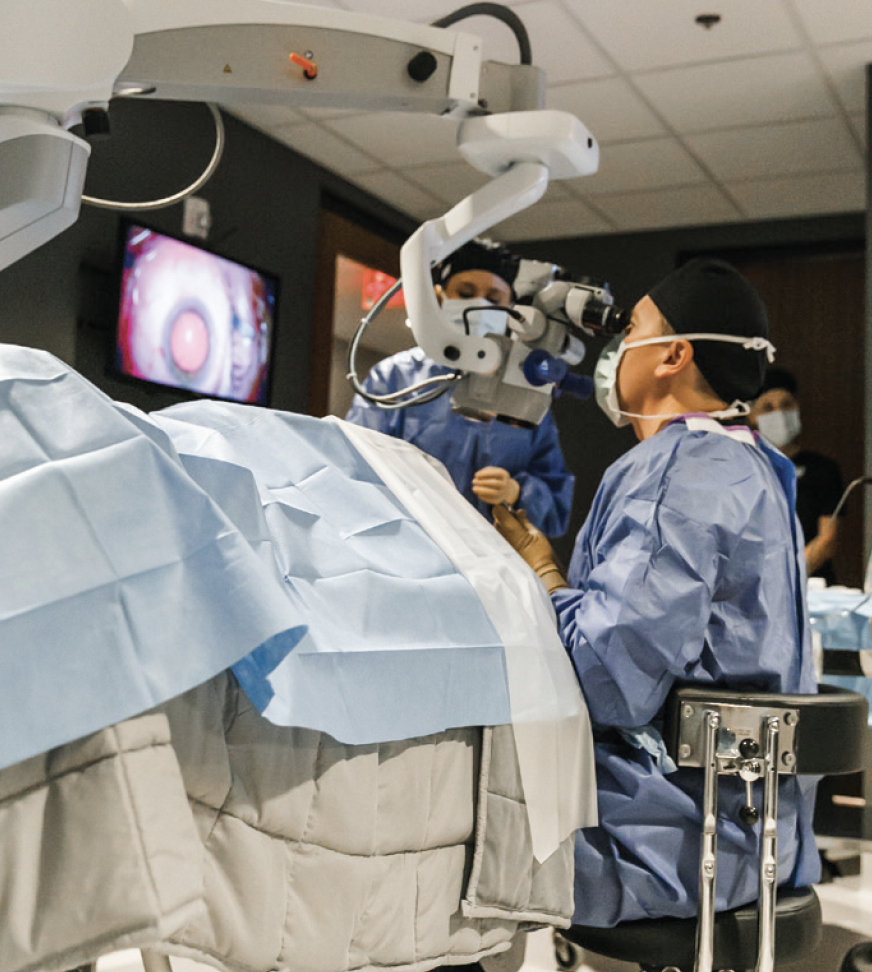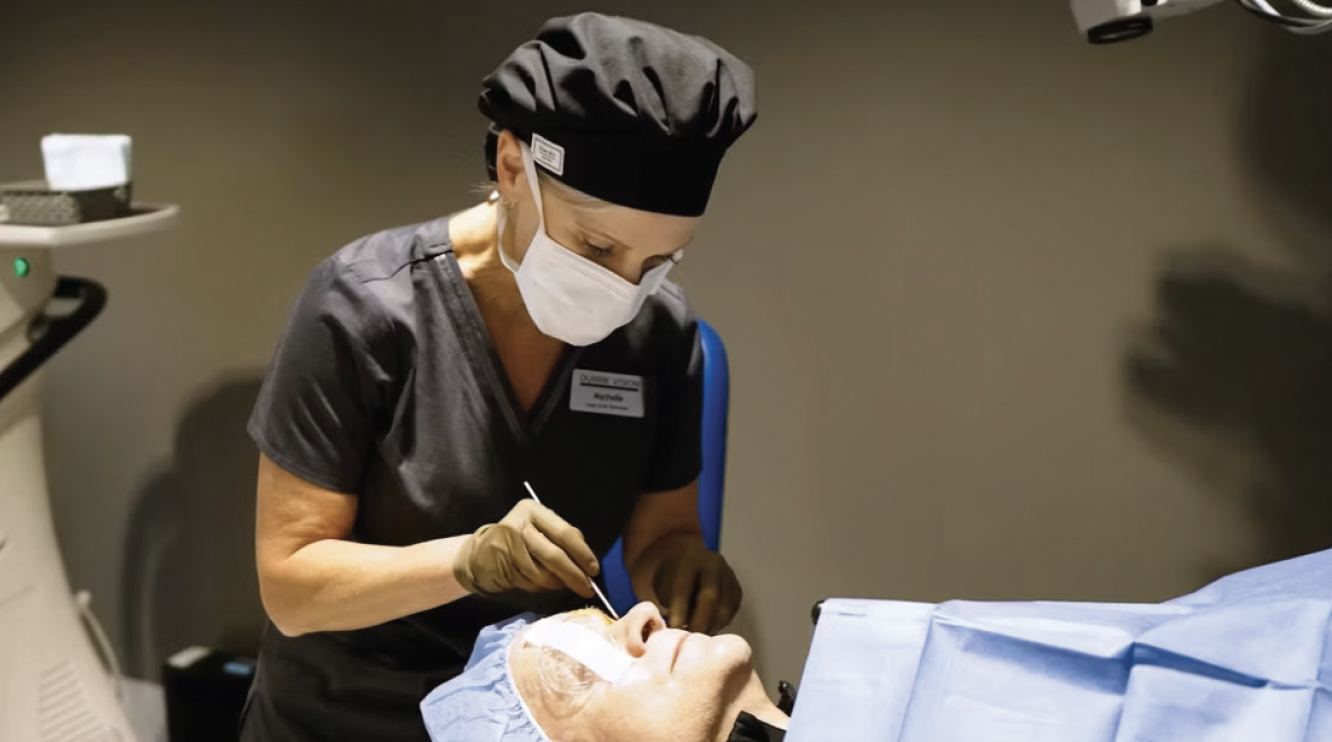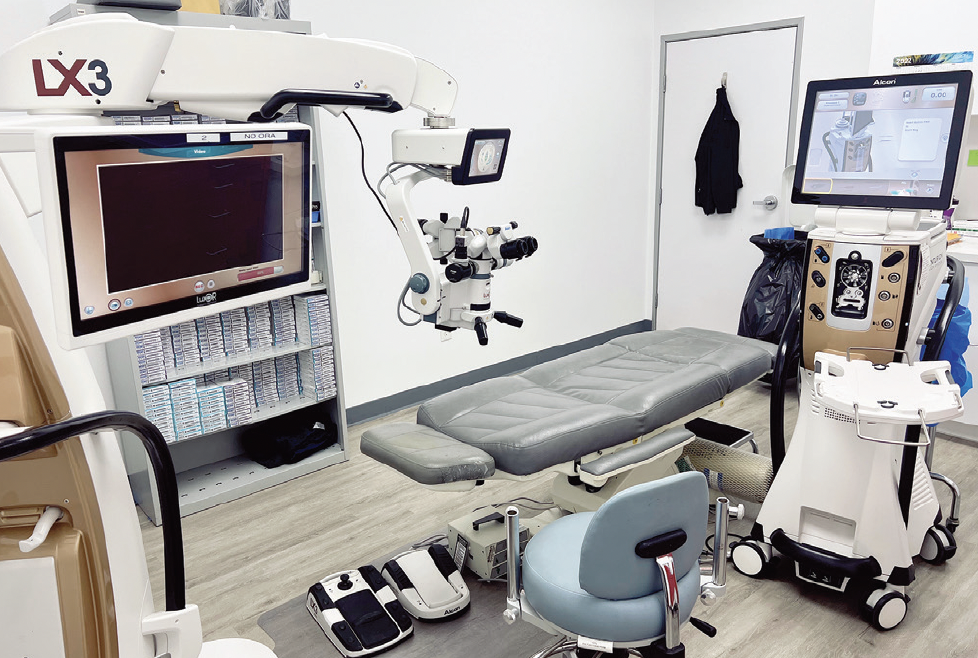
Over the past 5 years, ophthalmic surgery has increasingly shifted from hospitals and ambulatory surgery centers (ASCs) to office-based operating suites (Figure 1). To date, nearly 150 US practices have established modern, surgical spaces capable of safely accommodating a full range of procedures, including cataract, glaucoma, retinal, and oculoplastic surgeries. Based on the iRWD registry, iOR Partner’s data collection of more than 40,000 cases, cataract procedures are the most common form of office-based surgery (OBS).

Figure 1. Office-based surgery at Durrie Vision.
Self-pay procedures such as refractive lens exchange (RLE) and the implantation of phakic and premium IOLs can improve a practice’s profitability, particularly in the face of reduced Medicare reimbursement for cataract surgery. This improvement is generally greater when the procedure is performed in an office-based surgical suite, where overhead costs are lower.
TREND ANALYSIS
Of the approximately 7,000 private ophthalmology practices in the United States,1 less than 3% have in-office surgical suites. This market segment, however, is growing.
iOR Partners helps ophthalmology practices develop and manage office-based surgical suites. By the end of 2019, we had worked with four centers to develop in-house ORs. Today, that number has expanded to 95.
According to a log of the 47,492 ophthalmic OBS procedures conducted at iOR Partner practices through Q2 2023, cataract surgery accounted for 29,187 of the cases, RLE for 11,692, and phakic IOL (EVO ICL, STAAR Surgical) implantation for 2,714. In the United States, the proportion of cataract surgeries executed in an office-based setting rose to 2.2% in Q1 2023,2 up from 0.9% in 2021 and 0.5% in 2020.3 Moreover, the volume of RLE and ICL procedures performed in an office-based setting at iOR Partner practices increased by 49% from 2022 to 2023.
SAFETY
The growing trend toward OBS is substantiated by research demonstrating that its safety profile is comparable to that of surgeries performed in other health care settings.4 It is worth noting that office-based surgeries are under regulatory oversight in all 50 states and adhere to the same safety protocols as hospitals and ASCs. Furthermore, these suites are required to comply with evolving standards for malpractice compliance.
A 2023 retrospective study evaluated 18,005 cataract, RLE, and ICL surgeries conducted at 36 US practices between August 2020 and May 2022.5 The rate of adverse events (ie, postoperative unplanned vitrectomy, iritis, corneal edema, and endophthalmitis) was equal to or better than that associated with cataract surgery conducted in other settings.
PROFITABILITY
OBS allows practices greater control over their schedules and increases surgeon, employee, and patient satisfaction.6,7 Financially, practices that offer OBS can realize increased reimbursement by avoiding fees associated with hospital or ASC ORs. Moreover, iOR Partners has observed an increased patient preference for lens-based refractive and cataract surgeries with premium IOLs in an office-based environment (Figure 2).8 This preference may be due to the familiar environment and presence of trusted staff, which can increase patient comfort.

Figure 2. Dr. Durrie undergoes premium IOL surgery at an office-based suite (watch a related video below).
Ophthalmology practices with office-based surgical suites that initially focused on LASIK are well positioned to begin offering RLE and ICL procedures. Cataract surgeons who do not offer self-pay premium services but wish to enter this market may consider building office-based suites to expand into these areas (see What You Need for Office-Based Surgery to learn more). Practices that already have office-based surgical suites do not need to add equipment to offer private-pay services. The focus should instead be on improving customer service because charging premium prices requires delivering a premium experience. This typically involves changes in marketing, staff retraining, and creating a boutique atmosphere that minimizes wait times. The commitment and learning curve are significant, but guidance is available both privately and through industry societies.
What You Need for Office-Based Surgery
Advice on building your own suite.
By Dagny Zhu, MD

An office-based surgery (OBS) suite was already established in the practice I bought after my fellowship in 2018. During the past 5 years, I have performed thousands of eye surgeries there. Initially, I was nervous about operating outside an ambulatory surgery center (ASC) or hospital. Operating in an OBS suite, however, has changed my life as a surgeon and practice owner. In addition to cataract and custom lens replacement surgeries, I also routinely perform phakic IOL implantation, pterygium excision, and intrastromal corneal ring segment placement. This article outlines key considerations if you are considering building an OBS suite.
ADVANTAGES
OBS is most feasible for surgeons in Certificate of Need states where building or owning an ASC is restricted. It’s also ideal for early-career surgeons and those in large, crowded metropolitan areas with limited partnership opportunities and high ASC startup costs. An OBS suite can be built more quickly than an ASC (3–6 months vs 1–2 years).
OBS suites meet the same safety standards as ASCs and hospital outpatient departments (HOPDs). Large studies have shown that cataract surgery safety is comparable across OBS suites, ASCs, and HOPDs.1,2
An argument against performing cataract surgery in an OBS suite is that the regulatory and procedural costs (eg, supplies, drugs, equipment) are similar to those at an ASC or HOPD. OBS, however, can decrease expenses in several areas.
No. 1: Reduced staffing. Existing clinical staff, including scrub technicians, circulators, and pre- and postoperative staff, can be trained for OR duties.
No. 2: Less anesthesia. Class A anesthesia designation is often sufficient for routine cataract surgery in an OBS suite, removing the need for an anesthesia provider and avoiding IV-related delays. A Class B anesthesia designation is available to surgeons who prefer IV anesthesia monitored by an anesthesiologist or certified registered nurse anesthetist for routine or medically complex cases.
No. 3: Increased efficiency. The flexibility in time (ie, surgical scheduling) and location (ie, the OR and clinic can run simultaneously) allows a greater number of patients to be seen and treated.
No. 4: Fee differences. Although OBS does not have a facility fee, enhanced professional fees from Medicare and private insurers can offset overhead costs.
No. 5: Additional advantages. These include patient familiarity with the location and staff, reduced patient anxiety due to this familiarity and the avoidance of an IV, flexible scheduling, and increased convenience.
BUILDING AN OBS SUITE
Class A and Class B OBS suites require as little as 500 and 750 square feet, respectively, for the OR and a minimum of 200 additional square feet for the other areas. Seek a space at least 15 feet wide, unobstructed by columns or piping, for the OR. Feasibility also depends on the location of available plumbing, ventilation, and the entrance as well as their proximity to exterior walls.
OR. The OR must be constructed according to local regulatory building and fire codes. It must also meet ophthalmic-specific accreditation requirements.
The essential equipment—surgical bed or patient gurney, operating microscope, and phaco machine—mirrors what is found in an ASC (Figure). My OR has ample cabinet space for the storage of commonly used surgical supplies, instruments, and IOL consignments. It also has a patient vital signs monitor (blood pressure, oxygen saturation, and electrocardiogram leads) and a fully stocked crash cart.

Figure. Dr. Zhu’s OBS suite.
Sterile processing room. This room houses equipment, such as sinks and autoclaves, needed for instrument sterilization. Opt for small, high-speed, short-cycle autoclaves for quick turnaround and have backup units for contingencies.
Sterile supply room. Stock this room with all the necessary OBS medications and supplies, including gowns, masks, gloves, drapes, and surgery packs. Additionally, the room should have a refrigerator and cabinet for the storage of medications. My supply room also contains consignments of less commonly used IOLs.
I recommend locating the supply room adjacent to the OR and sterile processing room for convenience.
Patient waiting area. A comfortable space for waiting patients and postoperative care is essential. Hospital beds or recliner chairs work well, and a display screen can play educational videos or relaxing music.
Postoperative considerations. Patients receiving oral sedation typically experience minimal postoperative headache, nausea, and drowsiness and can be safely discharged shortly after surgery.
1. Ianchulev T, Litoff D, Ellinger D, Stiverson K, Packer M. Office-based cataract surgery: population health outcomes study of more than 21 000 cases in the United States. Ophthalmology. 2016;123(4):723-728.
2. Real-world data collection for ophthalmic office-based surgery. iOR Partners. Updated April 12, 2023. Accessed September 7, 2023. https://iorpartners.com/knowledge-resources/white-papers-presentations-case-studies/ior-partners-obs-occurrence-data
CONCLUSION
The transition to OBS is a rational evolution because it can streamline clinic workflow, increase patient comfort and satisfaction, and create new revenue streams. This trend could fundamentally change practice patterns within the field of ophthalmologic surgery.
1. Nabity J. How to start a successful ophthalmology practice. Physicians Thrive. Updated July 18, 2022. Accessed August 23, 2023. https://tinyurl.com/y7dvyphb.
2. ASCs account for 86.3 percent of ophthalmic procedures in Q1-2023. Market Scope Ophthalmic Market Perspectives. 2023;27(6):16.
3. 2021 Annual sponsored US cataract surgeon survey report: Measurement of perceptions of ophthalmic manufacturers, practice patterns, product market share, and plans for 2021. Market Scope. 2021;4.
4. Ianchulev T, Litoff D, Ellinger D, Stiverson K, Packer M. Office-based cataract surgery: population health outcomes study of more than 21 000 cases in the United States. Ophthalmology. 2016;123(4):723-728.
5. Kugler LJ, Kapeles M, Durrie DS. Safety of office-based lens surgery: a U.S. multicenter study. J Cataract Refract Surg. 2023;49(9):907-911.
6. Melendez, RF. The control and convenience of office-based surgery. Cataract & Refractive Surgery Today. March 2021. Accessed August 23, 2023. https://crstoday.com/articles/mar-2021/the-control-and-convenience-of-office-based-surgery.
7. Yim CK, Dave A, Strawn A, Chan J, Zhou I, Zhu DC. Visual outcomes and patient satisfaction after bilateral refractive lens exchange with a trifocal intraocular lens in patients with presbyopia. Ophthalmol Ther. 2023;12:1757-1773.
8. Durrie D. Paper presented at Refractive Surgery Alliance Conference; August 2, 2023; Dublin, Ireland.




